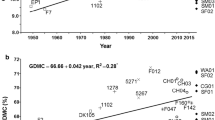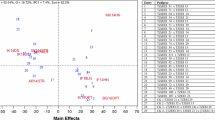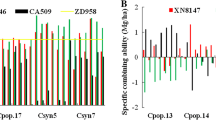Abstract
Future maize (Zea mays L.) genetic gains are dependent on the incorporation of unique and useful genetic diversity to breeding programs actively improving germplasm and developing cultivars. Our ultimate goal is to increase the genetic diversity currently available in early maturing maize hybrids by developing novel lines that can be utilized competitively in the northern US Corn Belt. A long-term breeding project (EarlyGEM) was initiated to move US Germplasm Enhancement Maize (GEM) germplasm northward and westward. Nine out of 152 breeding crosses were adapted and data from one breeding cross is presented. Five hundred BC1:S1 lines derived from (AR16026:S17-66-1-B × ND2000) × ND2000 were advanced, selected, and crossed to several commercial testers for early and late generation hybrid testing. Experiments were arranged in various partially balanced lattice designs and grown across 23 North Dakota (ND) environments. Data showed experimental GEM-derived hybrids had better grain yield (10.4 vs. 9.2 t ha−1), test weight (72.5 vs. 70.1 kg h L−1), extractable starch (67.8 vs. 64.2%) and fermentable starch, grain oil (4.3 vs. 3.5%), and grain protein (10.5 vs. 9.4%) when compared to popular hybrids at similar grain moisture at harvest. This is the first research incorporating GEM-derived tropical and late-temperate genetic materials for inbred line development representing a relative maturity (RM) below 90 days. As a consequence of these breeding efforts GEM materials were adapted to the northern US Corn Belt and are not only sources of useful and unique novel genetic diversity but also competitive products for industry use as requests for experimental EarlyGEM lines have been extensive. This research has practical implications with regards to new ways of conducting maize breeding for high latitudes.




Similar content being viewed by others
References
Albrecht B, Dudley JW (1987) Evaluation of four maize populations containing different proportions of exotic germplasm. Crop Sci 27:480–486
Carena MJ (2005) Maize commercial hybrids compared to improved population hybrids for grain yield and agronomic performance. Euphytica 141:201–208
Carena MJ (2007) Maize population hybrids: successful genetic resources for breeding programs and potential alternatives to single-cross hybrids. Acta Agronomica Hung 55:27–36
Carena MJ, Wanner DW (2003) Registration of ND2000 inbred line of maize. Crop Sci 43:1568–1569
Carena MJ, Wicks ZW III (2006) Maize early maturing hybrids: an exploitation of U.S. temperate public genetic diversity in reserve. Maydica 51:201–208
Carena MJ, Eno C, Wanner DW (2008) Registration of NDBS11(FR-M)C3, NDBS1011, and NDBSK(HI-M)C3 maize germplasm. J Plant Reg 2:132–136
Carena MJ, Wanner DW, Yang J (2009) Linking pre-breeding for local germplasm improvement with cultivar development in maize breeding for short-season (85-95RM) hybrids J Plant Reg (in press)
Duvick DN (1981) Genetic rates of gain in hybrid maize during the last 40 years. Maydica 22:187–196
East EM (1908) Inbreeding in corn. Connecticut Agric Exp Stn Rep 1907:419–428
Eberhart SA, Salhuana W, Sevilla R, Taba S (1995) Principles for tropical maize breeding. Maydica 40:339–355
Gardner CO (1961) An evaluation of effects of mass selection and seed irradiation with thermal neutrons on yield of corn. Crop Sci 1:241–245
Goodman MM (1965) Estimates of genetic variance in adapted and exotic populations of maize. Crop Sci 5:87–90
Griffing B, Lindstrom EW (1954) A study of combining abilities of corn inbreds having varying proportions of Corn Belt and non-Corn Belt germplasm. Agron J 46:845–852
Hallauer AR, Carena MJ (2009) Maize breeding. In: Carena MJ (ed) Handbook of plant breeding: cereal breeding. Springer, NY
Olson PJ, Walster HL, Hooper TH (1927) Corn for North Dakota. North Dakota Agric Exp Stn Bull 207
Osorno JM, Carena MJ (2009) Creating groups of maize genetic diversity for grain quality: implications for breeding. Maydica 53:131–141
Pollak LM (1993) Evaluation of Caribbean maize accessions in Puerto Rico. Trop Agric (Trinidad) 70:8–12
Pollak LM (2003) The history and success of the public-private project on germplasm enhancement of maize (GEM). Adv Agron 78:45–87
Rinke EH, Sentz JC (1961) Moving Corn Belt Dent germplasm northward. Minnesota Agr Exp Sta 1110:53
Russell WA (1972) Registration of B70 and B73 parental lines of maize. Crop Sci 12:721
Salhuana W, Pollak LM, Ferrer M, Paratori O, Vivo G (1998) Agronomic evaluation of maize accessions from Argentina, Chile, the United States, and Uruguay. Crop Sci 38:866–872
SAS (1989) SAS/STAT user’s guide. Version 6, vol 2, 4th edn. SAS Inst., Inc., Cary
Shull GH (1909) A pure line method of corn breeding. Am Breeders’ Assoc Rep 5:51–59
Smith S (2007) Pedigree background changes in US Hybrid Maize between 1980 and 2004. Crop Sci 47:1914–1926
Sprague GF (1946) Early testing of inbred lines of maize. J Am Soc Agron 38:108–117
Acknowledgments
The senior author dedicates this research and its presentation in this Special Euphytica Issue to Dr. Wilfredo Salhuana for his tireless efforts to increase the genetic diversity of maize hybrids through the LAMP and GEM projects. Monsanto cooperators provided the equipment and calibration for grain quality.
Author information
Authors and Affiliations
Corresponding author
Rights and permissions
About this article
Cite this article
Carena, M.J., Pollak, L., Salhuana, W. et al. Development of unique and novel lines for early-maturing hybrids: moving GEM germplasm northward and westward. Euphytica 170, 87–97 (2009). https://doi.org/10.1007/s10681-009-9985-5
Received:
Accepted:
Published:
Issue Date:
DOI: https://doi.org/10.1007/s10681-009-9985-5




